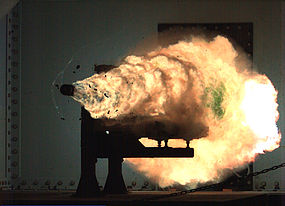
Back ريلغان Arabic Canó electromagnètic Catalan Elektromagnetické dělo Czech Railgun Danish Railgun German Elektromagneta kanono Esperanto Cañón de riel Spanish ریلگان Persian Raidetykki Finnish Canon électrique French

A railgun or rail gun is a linear motor device, typically designed as a weapon, that uses electromagnetic force to launch high-velocity projectiles. The projectile normally does not contain explosives, instead relying on the projectile's high kinetic energy to inflict damage.[2] The railgun uses a pair of parallel conductors (rails), along which a sliding armature is accelerated by the electromagnetic effects of a current that flows down one rail, into the armature and then back along the other rail. It is based on principles similar to those of the homopolar motor.[3]
As of 2020, railguns have been researched as weapons utilizing electromagnetic forces to impart a very high kinetic energy to a projectile (e.g. APFSDS) rather than using conventional propellants. While explosive-powered military guns cannot readily achieve a muzzle velocity of more than ≈2 km/s (Mach 5.9), railguns can readily exceed 3 km/s (Mach 8.8). For a similar projectile, the range of railguns may exceed that of conventional guns. The destructive force of a projectile depends upon its kinetic energy (proportional to its mass and the square of its velocity) at the point of impact. Because of the potentially higher velocity of a railgun-launched projectile, its force may be much greater than conventionally launched projectiles of the same mass. The absence of explosive propellants or warheads to store and handle, as well as the low cost of projectiles compared to conventional weaponry, are also advantageous.[4]
Railguns are still very much at the research stage after decades of R&D, and it remains to be seen whether they will be deployed as practical military weapons in the foreseeable future. Any trade-off analysis between electromagnetic (EM) propulsion systems and chemical propellants for weapons applications must also factor in its durability, availability and economics, as well as the novelty, bulkiness, high energy demand, and complexity of the pulsed power supplies that are needed for electromagnetic launcher systems.
- ^ Fletcher, Seth (5 June 2013). "Navy Tests 32-Megajoule Railgun |". Popular Science. Archived from the original on 4 June 2013. Retrieved 16 June 2013.
- ^ "rail gun". dictionary.com. Archived from the original on 26 April 2017. Retrieved 18 July 2017.
- ^ Rashleigh, C. S. & Marshall, R. A. (April 1978). "Electromagnetic Acceleration of Macroparticles to High Velocities". Journal of Applied Physics. 49 (4): 2540. Bibcode:1978JAP....49.2540R. doi:10.1063/1.325107.
- ^ "Rail Strike". The Economist. 9 May 2015. Archived from the original on 17 May 2015. Retrieved 31 January 2016.
© MMXXIII Rich X Search. We shall prevail. All rights reserved. Rich X Search